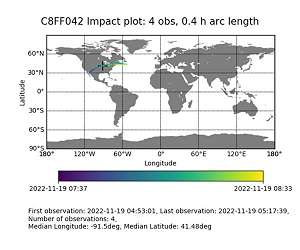A Martian megatsunami may have been caused by an asteroid collision similar to the Chicxulub impact – which contributed to the mass extinction of all non-avian dinosaurs on Earth 66 million years ago – in a shallow ocean region, according to a study published in Scientific Reports.
Previous research has proposed that an asteroid or comet impact within an ocean in the Martian northern lowlands may have caused a megatsunami approximately 3.4 billion years ago. However, prior to this study the location of the resulting impact crater was unclear.
Alexis Rodriguez and colleagues analysed maps of Mars’ surface, created by combining images from previous missions to the planet, and identified an impact crater that could have caused the megatsunami. The crater – which they have named Pohl – has a diameter of 110 kilometres and is located within an area of the northern lowlands that previous studies have suggested may have been covered by an ocean, in a region around 120 metres below its proposed sea level. The authors suggest that Pohl may have formed around 3.4 billion years ago based on its position above and below rocks previously dated to this time.
The authors simulated asteroid and comet collisions with this region to test what type of impact that could have created Pohl and whether this could have led to a megatsunami. They found that the simulations that formed craters with similar dimensions to Pohl were caused by either a nine kilometre asteroid encountering strong ground resistance – releasing 13 million megatons of TNT energy – or a three kilometre asteroid encountering weak ground resistance – releasing 0.5 million megatons of TNT energy.
The amount of energy released by Tsar Bomba, the most powerful nuclear bomb ever tested, was approximately 57 megatons of TNT energy. Both simulated impacts formed craters measuring 110 kilometres in diameter and generated megatsunamis that reached as far as 1,500 kilometres from the centre of the impact site. Analysis of the megatsunami caused by the three kilometre asteroid impact indicated that this tsunami may have measured up to approximately 250 metres tall on land.
The authors suggest that the aftermath of the proposed Pohl impact may have had similarities with the Chicxulub impact on Earth, which previous research has suggested occurred within a region 200 metres below sea level, generated a crater with a temporary diameter of 100 kilometres, and led to a megatsunami that was 200 metres high on land.
Research Report:Evidence of an oceanic impact and megatsunami sedimentation in Chryse Planitia, Mars
Related Links
Planetary Science Institute
Asteroid and Comet Mission News, Science and Technology
|
We need your help. The SpaceDaily news network continues to grow but revenues have never been harder to maintain. With the rise of Ad Blockers, and Facebook – our traditional revenue sources via quality network advertising continues to decline. And unlike so many other news sites, we don’t have a paywall – with those annoying usernames and passwords. Our news coverage takes time and effort to publish 365 days a year. If you find our news sites informative and useful then please consider becoming a regular supporter or for now make a one off contribution. |
||
|
SpaceDaily Monthly Supporter $5+ Billed Monthly |
SpaceDaily Contributor $5 Billed Once credit card or paypal |
|

![]()
The sixth asteroid impact we saw coming
Paris (ESA) Nov 25, 2022
For the second time this year, a small asteroid has been discovered before impacting the Earth. This time the discovery came from the Catalina Sky Survey, one of the major projects dedicated to the discovery and follow-up of NEOs, and already responsible for the discovery of the first three such cases between 2008 and 2018.
The new asteroid, now officially designated 2022 WJ1, was first imaged by the 1.5-metre Mt. Lemmon telescope at 04:53 UTC on 19 November, but the object was first reported to t … read more











